Figuring out what gear your bike should be in is key to enjoying your rides and optimizing your performance. At usabikers.net, we’ll break down the mechanics, explore different bike setups, and help you choose the right gear for any terrain. By understanding these fundamentals, you’ll maintain an efficient pedaling cadence and enhance your overall biking experience.
1. Understanding Bike Gears: The Basics
1.1. How is the Number of Bike Gears Determined?
The number of gears on a bike is determined by multiplying the number of chainrings at the front by the number of sprockets at the rear. For instance, a bike with two chainrings and a 12-speed cassette has 24 gears. This simple calculation helps riders understand the range of options available to them.
1.2. Why Are Gears Important on a Road Bike?
Gears on a bike allow you to maintain a comfortable pedaling speed, regardless of the terrain. This adaptability is crucial because no single gear can handle all conditions efficiently. Gears enable cyclists to optimize their energy output and maintain a steady rhythm, enhancing both performance and enjoyment.
- High Gears: Ideal for descending or high-speed riding, high gears combine the largest front chainring with the smallest rear sprocket.
- Low Gears: Best for steep inclines, low gears pair the smallest front chainring with the largest rear sprocket, aiding in easier pedaling uphill.
It’s important to understand that having many gears isn’t just about speed; it’s about efficiency. More gears provide a broader range of options, allowing cyclists to find their ideal pedaling speed for various conditions. Just like a car uses different gears for different situations, bikes benefit from having a wide selection to match the terrain and effort level.
1.3. What is Cadence?
Cadence refers to the rate at which a cyclist pedals, typically measured in revolutions per minute (RPM). Maintaining an optimal cadence is crucial for efficient cycling, as it balances muscle fatigue and cardiovascular effort. Gears allow cyclists to adjust their pedaling resistance to keep their cadence within a comfortable range, regardless of the terrain or speed. By understanding cadence, riders can maximize their performance and minimize strain on their bodies.
1.4. The Advantage of Multiple Gears
Modern bikes with 12 and 13-speed cassettes offer smaller gaps between gears, allowing for finer adjustments to pedaling speed. This means riders can more easily find the perfect gear to maintain an efficient cadence, reducing energy expenditure and improving overall performance. Smaller gear increments result in more precise shifting, as the chain has less distance to move between sprockets.
1.5. Why Choose a Single Speed Bike?
Single-speed bikes offer simplicity and low maintenance, making them a popular choice for commuting in flat areas. They eliminate the complexity of multiple gears and require minimal upkeep. While single-speed bikes may not be suitable for all terrains, they are a great option for those seeking a straightforward and reliable riding experience. Some racers and track cyclists also prefer single-speed bikes for weight reduction and simplicity.
 Cyclist climbing a mountain with visible bike gears
Cyclist climbing a mountain with visible bike gears
1.6. Overlapping Gears: The Reality of Multi-Geared Setups
In multi-geared setups, overlapping gears are unavoidable, meaning some gear combinations provide the same ratio as others using different sprockets and chainrings. While not all gears are unique, the ability to have a continuous progression of closely spaced gears enhances pedaling efficiency. Avoiding extreme gear combinations, known as “crossing the chain,” can reduce strain on the chain and prolong its lifespan.
1.7. Maximizing Efficiency with Gearing Options
Today’s extensive range of gearing options allows cyclists of all abilities to optimize their pedaling. Understanding the different types of bike gears and how they work can help riders choose the setup that best suits their riding style and terrain. The right gearing ensures efficient and comfortable cycling experiences.
2. Different Types of Bike Gears and How They Work
2.1. Standard Double
A standard double setup includes two chainrings at the front and up to 12 sprockets at the rear. Traditionally, a 53-39t combination was considered standard, but modern recreational cyclists rarely use it. Standard doubles are still preferred in racing because they offer the largest chainring sizes for high-speed pedaling.
2.2. Compact
A compact setup features smaller chainrings, typically a 34t or 36t inner ring paired with a 48t or 50t outer ring. This reduces the gear ratio across the range, making it easier to tackle steep climbs. Compact setups are a popular choice for recreational cyclists, as they provide sufficient low-end gearing without sacrificing too much top-end speed.
2.3. Semi-Compact
Semi-compact chainsets have gained popularity, offering a 52t outer chainring and a 36t inner ring. This combination provides a balance between climbing ability and high-speed performance. The 36t inner ring paired with a wide-range cassette allows riders to tackle most climbs, while the 52t outer ring provides ample gearing for fast group rides and descents.
2.4. Triple
Triple cranksets, though less common today, are found on hybrid and touring bikes. They offer a wide gearing range without needing many sprockets on the cassette. The small inner rings provide lower gears than double cranksets, making them ideal for loaded touring. Triple cranksets are a robust and cost-effective option for cyclists needing a broad gear range.
2.5. SRAM AXS
Launched in 2019, SRAM AXS groupsets offer smaller chainrings, such as 50/37T, 48/35T, and 46/33T. These groupsets use a 12-speed cassette starting with a 10-tooth sprocket, prioritizing small jumps between smaller sprockets and larger jumps between bigger sprockets. This design ensures smooth cadence changes during high-speed riding and plenty of low gears for climbing.
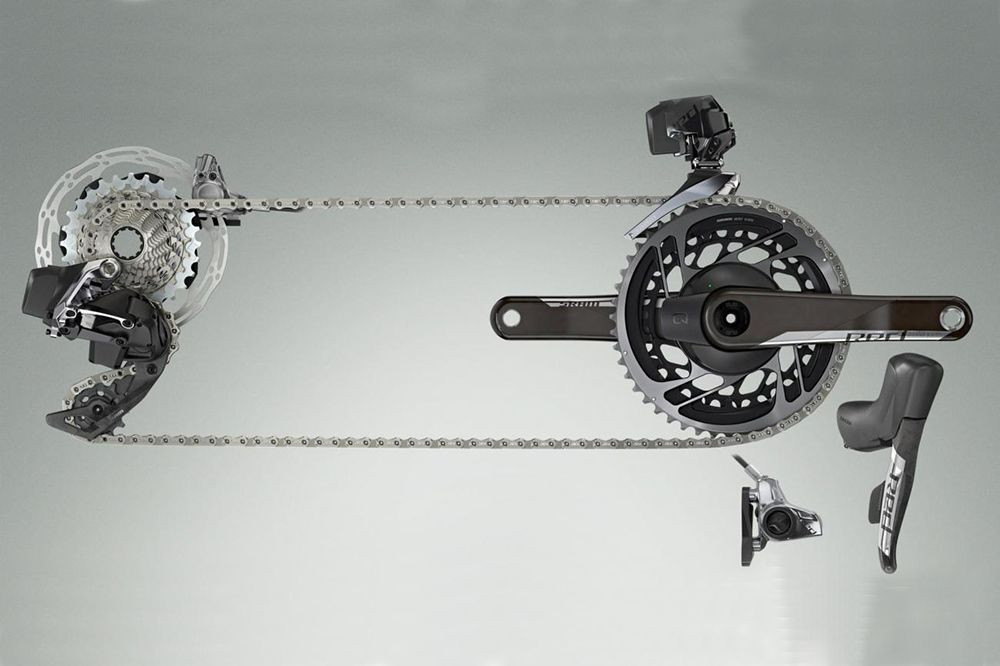 SRAM Red eTap AXS groupset
SRAM Red eTap AXS groupset
2.6. 1x or Single Chainring
Single chainring setups have become popular, pairing one chainring with a multi-speed cassette (typically 11, 12, or 13-speed). They simplify gear shifting by eliminating the front derailleur. Special chainrings and rear derailleurs with clutch mechanisms ensure chain retention. These setups are favored by gravel riders and those who prefer simplicity.
2.7. Hub Gears
Hub gears are robust, low-maintenance systems housed in the rear hub. The Rohloff hub offers 14 gears, while other options from SRAM, Shimano, and Sturmey-Archer provide fewer gears. While hub gears offer fewer individual gear choices than derailleur systems, they allow for ratio personalization by adjusting chainring and rear sprocket sizes. They are great for commuter bikes because they allow gear changes without pedaling.
2.8. Classified Powershift System
The Classified Powershift system, released in 2019, is a wireless electronic hub system offering 24 gears and instant shifting under load. This system requires a compatible wheelset but is gaining popularity. It offers a modern alternative to traditional hub gears.
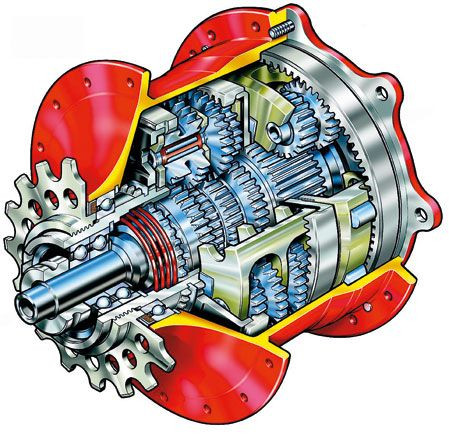 Hub-gears
Hub-gears
3. Road Bike Gear Shifters: How They Work
3.1. Mechanical Groupsets
In mechanical groupsets, the right-hand levers control the rear derailleur, while the left-hand levers control the front derailleur. This standard arrangement ensures consistency across different brands. If you are unsure how your shifters work, consult a local bike shop for guidance.
3.2. Electronic Gears
Electronic gears, like SRAM AXS and Shimano Di2, can be customized to the rider’s preference. These systems often use buttons or paddles to control shifting, allowing for precise and efficient gear changes. Electronic shifting provides a modern and customizable experience.
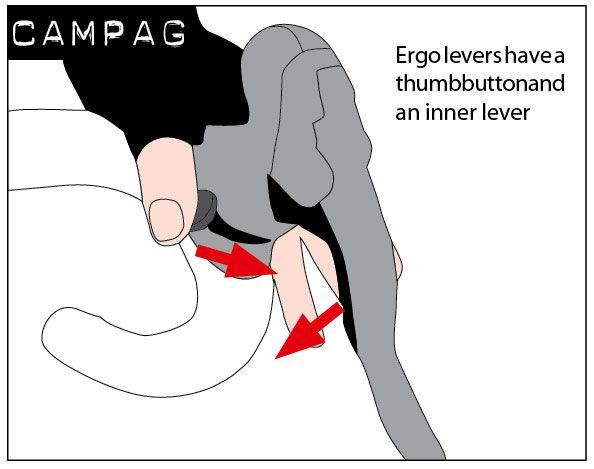 Diagram of Campagnolo road bike gear shifters
Diagram of Campagnolo road bike gear shifters
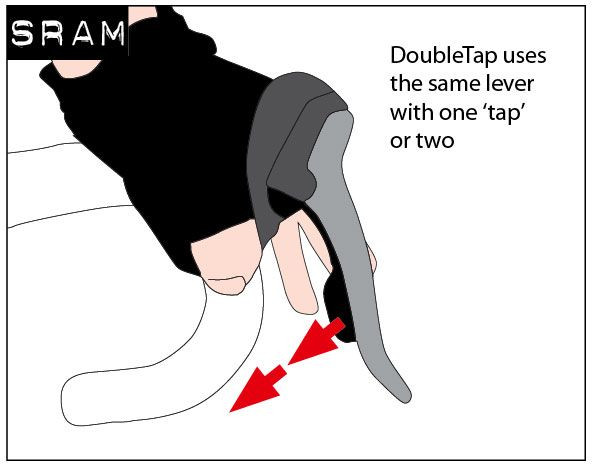 Diagram of SRAM road bike gear shifters
Diagram of SRAM road bike gear shifters
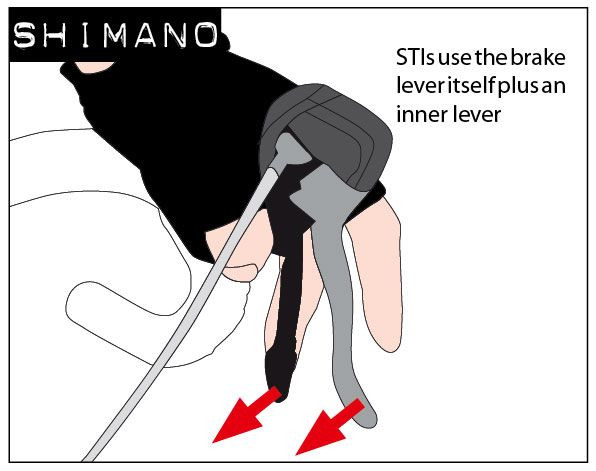 Diagram of Shimano road bike gear shifters
Diagram of Shimano road bike gear shifters
4. How Electric Road Bike Gear Shifting Works
4.1. Shimano Di2
Shimano’s electronic Di2 groupsets, including Dura-Ace, Ultegra, and 105, use a button system with the same principle as mechanical shifters. The left shifter controls the front derailleur, and the right controls the rear. Two buttons behind the brake lever on each shifter allow for easy gear changes.
- Left Shifter:
- Inner Button: Shifts the chain from the small ring to the big ring.
- Outer Button: Moves the chain from the big ring to the small ring.
- Right Shifter:
- Inner Button: Moves the chain up the cassette to easier gears.
- Outer Button: Moves the chain towards harder gears.
4.2. Campagnolo Super Record EPS
Campagnolo Super Record EPS shifters feature a button behind the brake lever and a thumb button inside the shifter hood. The right-hand shifter’s button behind the brake lever moves the chain up the cassette to an easier gear, while the thumb button moves the chain to a harder gear. EPS also offers multi-shift, allowing the chain to shift multiple gears when the button is held down.
- Right-Hand Shifter:
- Paddle Button: Moves the chain from the inner small ring to the larger outer ring.
- Thumb Button: Does the reverse.
Campagnolo has introduced Super Record WRL, a wireless groupset that replaces thumb buttons with buttons similar to Shimano and SRAM.
4.3. SRAM AXS
SRAM eTap AXS groupsets, including Red, Force, Rival, and Apex, use a different approach. The default setting uses two buttons. The right-hand paddle button moves the chain to a harder gear on the cassette, while the left-hand paddle button moves the chain to an easier gear. To move the chain between the front chainrings, the rider pushes both buttons simultaneously.
 Shimano Dura Ace shifter
Shimano Dura Ace shifter
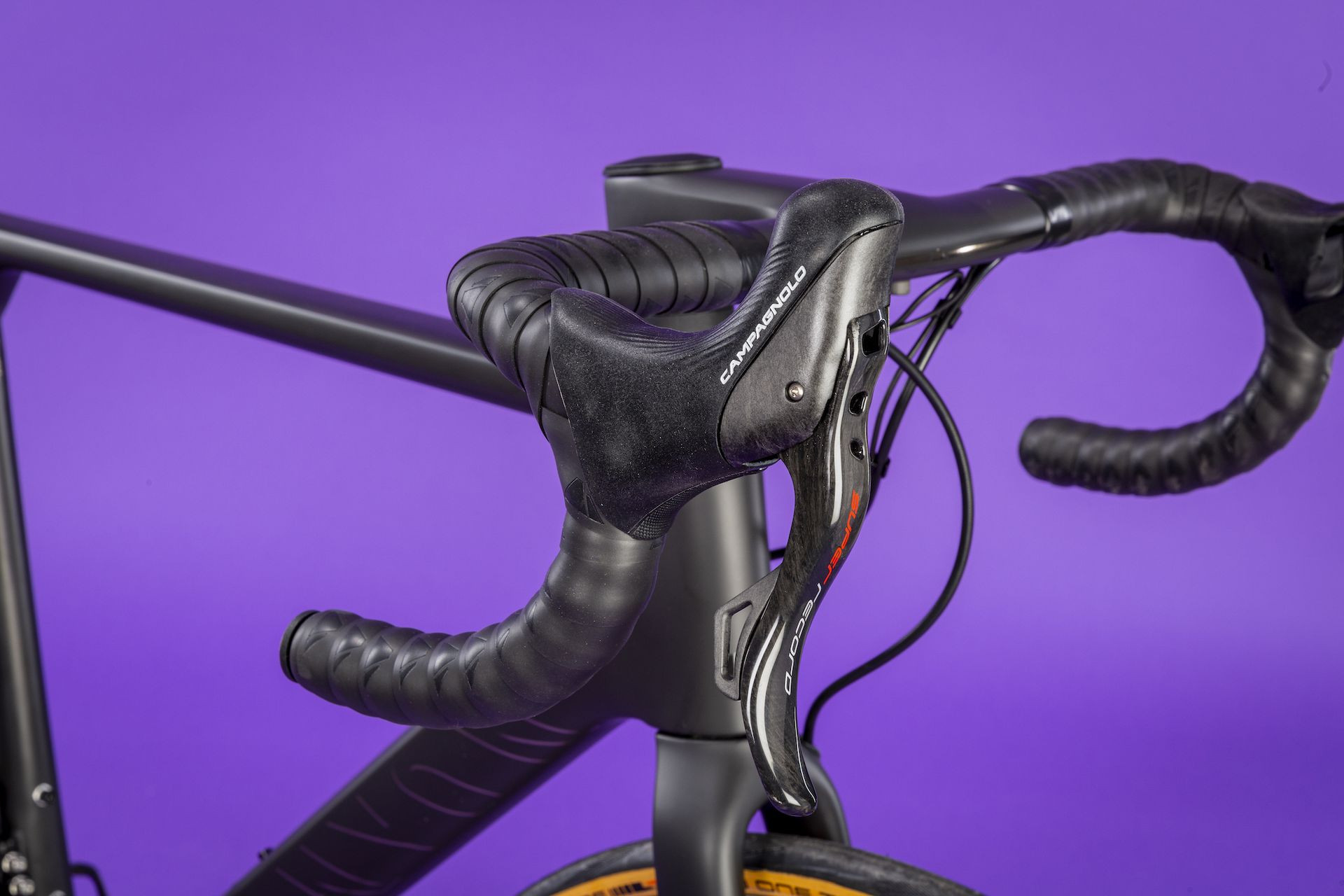 Campagnolo Super Record EPS shifter
Campagnolo Super Record EPS shifter
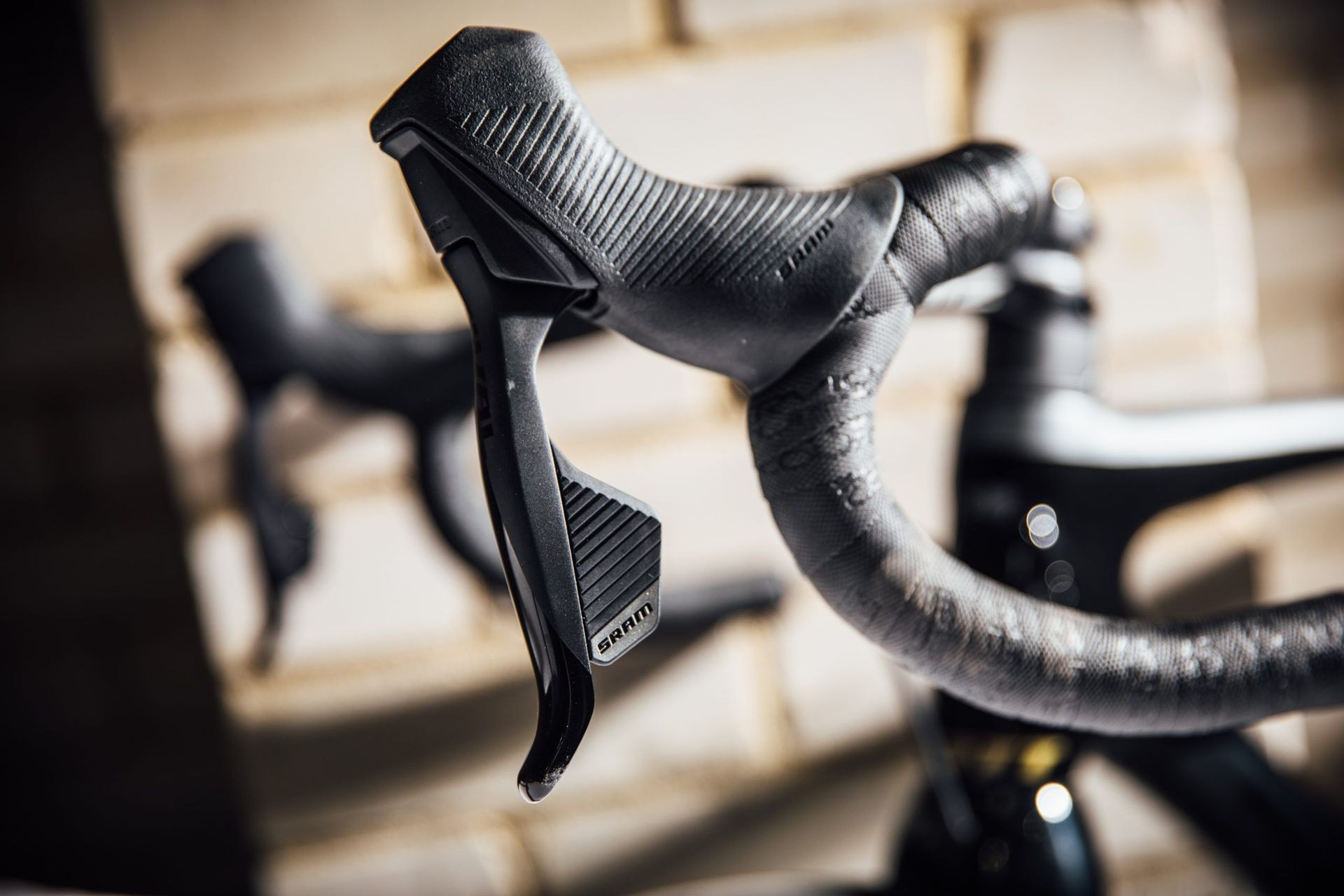 SRAM Rival eTap AXS shifter
SRAM Rival eTap AXS shifter
5. Bike Gear Glossary
| Term | Definition |
|---|---|
| Chainring | Toothed ring at the front end of the drivetrain, attached to the crank. |
| Cassette | Cluster of sprockets at the rear of the drivetrain, containing up to 12 gears of various sizes. |
| Block | Another term for the group of rear sprockets, but really refers to the older, screw-on freewheel. |
| Derailleurs | Front and rear derailleurs move the chain from one sprocket (or chainring) to the next. |
| Sprocket | Refers to an individual gear within the cassette/block. |
| Ratio | Describes the relationship between sprockets and chainrings, e.g., ‘53×12’, or the sprockets on a cassette (11-28). |
| t | Short for teeth — to describe how many a given sprocket has — e.g., ‘23t’. |
| Drivetrain | All moving parts that connect the crank to the rear wheel and drive a bicycle, including the chain, cassette, and chainrings. |
| Cadence | Pedaling speed, measured from how many revolutions the crank makes per minute (RPM). |
| STI lever | Abbreviation of ‘Shimano Total Integration’ — a term for Shimano’s design combining brake and shift levers for road bikes. |
| Ergo lever | Campagnolo’s name for its version of integrated gear shift and brake levers (Campagnolo’s STI). |
| DoubleTap lever | SRAM’s shifter technology uses the same lever for upshifts and downshifts. |
6. Understanding Search Intent for Bike Gears
Here are five key search intents related to the keyword “What Gear Should My Bike Be In”:
- Informational: Users want to understand the basics of bike gears and how they work.
- Comparative: Users are looking to compare different gearing systems (e.g., compact vs. standard) to determine which is best for them.
- Situational: Users need advice on what gear to use in specific situations, such as climbing hills or riding on flat terrain.
- Troubleshooting: Users are experiencing issues with their bike gears and need guidance on how to resolve them.
- Maintenance: Users want to know how to maintain their bike gears to ensure optimal performance and longevity.
7. Optimizing Your Bike Gears for Different Scenarios
7.1. Climbing Hills
When tackling steep inclines, shifting to a lower gear is essential. A smaller chainring in the front paired with a larger sprocket in the rear makes pedaling easier, allowing you to maintain a comfortable cadence without excessive strain. According to the Motorcycle Safety Foundation (MSF), maintaining a steady, lower gear on uphill climbs reduces the risk of losing momentum and provides better control.
7.2. Riding on Flat Terrain
On flat surfaces, a higher gear can help you maintain speed and efficiency. Using a larger chainring in the front and a smaller sprocket in the rear allows you to cover more distance with each pedal stroke. Adjust your gear to maintain a consistent cadence that feels comfortable and sustainable.
7.3. Descending
When descending, a higher gear is appropriate to control your speed and prevent over-revving. Combining the largest front chainring with a smaller rear sprocket will provide the necessary resistance. Be cautious and adjust your gear to match the steepness and conditions of the descent.
7.4. Starting and Stopping
When starting from a standstill, use a lower gear to make it easier to get moving. This reduces the amount of force required to turn the pedals and helps you accelerate smoothly. Similarly, when approaching a stop, shift to a lower gear so you’re prepared for an easy restart.
7.5. Riding in Windy Conditions
In windy conditions, maintaining a consistent cadence is crucial. Shift to a gear that allows you to pedal comfortably despite the wind resistance. Lower gears can help you maintain momentum when facing headwinds, while higher gears may be suitable for tailwinds.
8. Advanced Gearing Tips for Experienced Bikers
8.1. Anticipate Terrain Changes
Experienced riders anticipate changes in terrain and shift gears proactively. By shifting before you reach a hill or a flat section, you can maintain a consistent cadence and avoid sudden increases in effort. This technique improves efficiency and reduces strain on your muscles.
8.2. Use Gear Calculators
Gear calculators are online tools that help you visualize the relationship between different gear combinations. These calculators can help you understand how different chainring and sprocket sizes affect your gear ratios, allowing you to fine-tune your setup for specific rides.
8.3. Optimize Chainline
Maintaining a straight chainline, where the chain runs as directly as possible from the front chainring to the rear sprocket, reduces friction and improves efficiency. Avoid extreme gear combinations that cause the chain to run at a sharp angle. According to research from the American Motorcyclist Association (AMA), optimizing your chainline can significantly reduce wear and tear on your drivetrain.
8.4. Experiment with Cadence
Pay attention to your cadence and experiment with different pedaling speeds to find what feels most comfortable and efficient. Some riders prefer a higher cadence, while others prefer a lower one. Finding your optimal cadence can improve your endurance and reduce muscle fatigue.
8.5. Consider Power Meters
Power meters measure the amount of power you’re generating while pedaling. This data can help you optimize your gear choices by providing real-time feedback on your effort level. By monitoring your power output, you can choose gears that allow you to maintain a consistent and efficient level of exertion.
9. Common Mistakes to Avoid When Shifting Gears
9.1. Shifting Under Heavy Load
Shifting gears while applying heavy pressure to the pedals can damage your chain and derailleur. Ease up on the pedals slightly when shifting to allow the chain to move smoothly between gears.
9.2. Cross-Chaining
“Cross-chaining” refers to using extreme gear combinations, such as the largest front chainring with the largest rear sprocket or the smallest front chainring with the smallest rear sprocket. This puts unnecessary strain on the chain and can lead to premature wear and poor shifting performance.
9.3. Neglecting Maintenance
Regularly cleaning and lubricating your chain and derailleur is essential for smooth and reliable shifting. A dirty or dry chain will not shift as efficiently and can wear out more quickly.
9.4. Ignoring Unusual Noises
Pay attention to any unusual noises coming from your drivetrain. Clicking, grinding, or skipping sounds can indicate a problem with your gears that needs to be addressed.
9.5. Forgetting to Shift
Be mindful of your gear selection and shift proactively to maintain a comfortable cadence. Waiting too long to shift can result in sudden increases in effort and reduced efficiency.
10. Frequently Asked Questions (FAQ) About Bike Gears
10.1. What is the best gear to start in on a bike?
The best gear to start in is a low gear, which makes it easier to pedal from a standstill. A smaller chainring in the front and a larger sprocket in the rear will provide the necessary leverage.
10.2. How do I know when to shift gears on my bike?
Shift gears when your pedaling becomes too easy or too difficult. Adjust your gears to maintain a consistent and comfortable cadence.
10.3. What is the difference between high gear and low gear?
High gear is achieved by using a larger chainring in the front and a smaller sprocket in the rear, providing more resistance and allowing for higher speeds. Low gear uses a smaller chainring in the front and a larger sprocket in the rear, making pedaling easier for climbing.
10.4. How many gears do I need on my bike?
The number of gears you need depends on your riding style and the terrain you typically encounter. More gears provide finer control over your cadence, while fewer gears offer simplicity and lower maintenance.
10.5. Can I change gears while pedaling backward?
It is generally not recommended to change gears while pedaling backward, as it can cause the chain to derail or damage the drivetrain.
10.6. What does 1x, 2x, and 3x mean on a bike?
These notations refer to the number of chainrings on the front of the bike. A 1x setup has a single chainring, a 2x setup has two chainrings, and a 3x setup has three chainrings.
10.7. How often should I replace my bike chain?
Replace your bike chain approximately every 2,000 to 3,000 miles, or more frequently if you ride in harsh conditions or notice signs of wear.
10.8. What is the best way to clean my bike chain?
Use a chain cleaner tool or a brush and degreaser to remove dirt and grime from your chain. Rinse with water and apply a fresh coat of lubricant.
10.9. How tight should my bike chain be?
Your bike chain should have about ½ inch of play. Too tight or too loose can cause shifting problems and premature wear.
10.10. What are some signs that my bike gears need adjustment?
Signs that your bike gears need adjustment include difficulty shifting, skipping gears, chain falling off, and excessive noise from the drivetrain.
Navigating the world of bike gears can be complex, but understanding the basics can significantly enhance your riding experience. Whether you’re tackling steep climbs, cruising on flat terrain, or descending at high speeds, knowing what gear your bike should be in will improve your efficiency, comfort, and overall enjoyment.
Ready to explore more about bike gears, maintenance tips, and connect with a vibrant community of fellow bikers? Visit usabikers.net today to discover a wealth of resources, engage in discussions, and stay up-to-date with the latest trends in the biking world. Join us at 801 Sturgis Main St, Sturgis, SD 57785, United States, or call +1 (605) 347-2000. Let usabikers.net be your go-to destination for all things biking!

